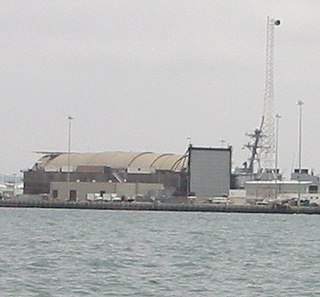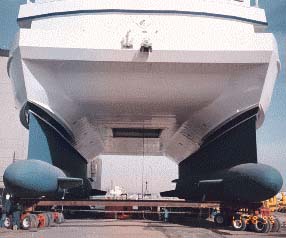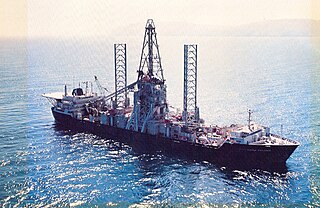
USS Swordfish (SSN-579), a Skate-class nuclear-powered submarine, was the second submarine of the United States Navy named for the swordfish, a large fish with a long, swordlike beak and a high dorsal fin.
Soviet submarine K-129 may refer to one or both of the following submarines of the Soviet Navy:

USS Halibut (SSGN-587), a unique nuclear-powered guided missile submarine-turned-special operations platform, later redesignated as an attack submarine SSN-587, was the second ship of the United States Navy to be named after the halibut.

Suisun Bay is a shallow tidal estuary in Northern California. It lies at the confluence of the Sacramento River and San Joaquin River, forming the entrance to the Sacramento–San Joaquin River Delta, an inverted river delta. To the west, Suisun Bay is drained by the Carquinez Strait, which connects to San Pablo Bay, a northern extension of San Francisco Bay. Grizzly Bay forms a northern extension of Suisun Bay. Suisun Bay is between Contra Costa County to the south and Solano County to the north.

Project 629, also known by the NATO reporting name Golf, was a class of diesel-electric ballistic missile submarines that served in the Soviet Navy. All boats of this class had left Soviet service by 1990, and have since been disposed of. According to some sources, at least one Golf-class submarine was operated by China, to test new submarine-launched ballistic missiles (SLBMs).

Trieste II(DSV-1) was the successor to Trieste – the United States Navy's first bathyscaphe purchased from its Swiss designers.
John Piña Craven was an American scientist who was known for his involvement with Bayesian search theory and the recovery of lost objects at sea. He was Chief Scientist of the Special Projects Office of the United States Navy.

The Hughes Mining Barge, or HMB-1, is a submersible barge about 99 m (324 ft) long, 32 m (106 ft) wide, and more than 27 m (90 ft) tall. The HMB-1 was originally developed as part of Project Azorian, the top-secret effort mounted by the Central Intelligence Agency to salvage the wreckage of the Soviet submarine K-129 from the ocean floor.

The Glomar Challenger was a deep sea research and scientific drilling vessel for oceanography and marine geology studies. The drillship was designed by Global Marine Inc. specifically for a long term contract with the American National Science Foundation and University of California Scripps Institution of Oceanography and built by Levingston Shipbuilding Company in Orange, Texas. Launched on March 23, 1968, the vessel was owned and operated by the Global Marine Inc. corporation. Glomar Challenger was given its name as a tribute to the accomplishments of the oceanographic survey vessel HMS Challenger. Glomar is a truncation of Global Marine.
In United States law, the term Glomar response, also known as Glomarization or Glomar denial, refers to a response to a request for information that will "neither confirm nor deny" (NCND) the existence of the information sought. For example, in response to a request for police reports relating to a certain individual, the police agency may respond with the following: "We can neither confirm nor deny that our agency has any records matching your request." The phrase was used in a request for information about the Glomar Explorer.

A moon pool is an equipment deployment and retrieval feature used by marine drilling platforms, drillships, diving support vessels, fishing vessels, marine research and underwater exploration or research vessels, and underwater habitats. It is also known as a wet porch. It is an opening found in the floor or base of the hull, platform, or chamber giving access to the water below. Because of its stable location, it safely allows technicians or researchers to lower tools and instruments into the sea.

The R/V Akademik Mstislav Keldysh is a 6,240 ton Russian scientific research vessel. It has made over 50 voyages, and is best known as the support vessel of the Mir submersibles. The vessel is owned by the Shirshov Institute of Oceanology of the Russian Academy of Sciences in Moscow, and is homeported in Kaliningrad on the Baltic Sea. Named after the Soviet mathematician Mstislav Keldysh, it usually has 90 people on board. Among its facilities are 17 laboratories and a library.
USS Harrier (AM-366) was an Admirable-class minesweeper built for the United States Navy. Laid down on 11 August 1943 by the Willamette Iron and Steel Works, Portland, Oregon, launched 7 June 1944, commissioned as USS Harrier (AM-366), 31 October 1945.

Hank Phillippi Ryan is an American investigative reporter for Channel 7 News on WHDH-TV, a local television station in Boston, Massachusetts. She is also an author of mystery novels.

Project Azorian was a U.S. Central Intelligence Agency (CIA) project to recover the sunken Soviet submarine K-129 from the Pacific Ocean floor in 1974 using the purpose-built ship Hughes Glomar Explorer. The 1968 sinking of K-129 occurred about 1,600 miles (2,600 km) northwest of Hawaii. Project Azorian was one of the most complex, expensive, and secretive intelligence operations of the Cold War at a cost of about $800 million, or $4.9 billion today.

K-129 was a Project 629A diesel-electric-powered ballistic-missile submarine that served in the Pacific Fleet of the Soviet Navy–one of six Project 629 strategic ballistic-missile submarines assigned to the 15th Submarine Squadron based at Rybachiy Naval Base near Petropavlovsk, commanded by Rear Admiral Rudolf Golosov.
Operation Matador was a Central Intelligence Agency plan in 1975 to utilize the recovery vessel Glomar Explorer to recover the remainder of the Soviet submarine K-129 left on the sea floor by the earlier Project Azorian. The operation was never conducted.
The National Underwater Reconnaissance Office (NURO) is the "hidden younger brother" of the National Reconnaissance Office (NRO). NRO was initiated in 1960 and developed as a common office for United States Air Force and the Central Intelligence Agency (CIA) to manage satellite reconnaissance. The first revelation about NRO came in 1973, but its very existence was not declassified until 1992. According to Jeffrey T. Richelson, "[m]ost often the Under Secretary of the Air Force served as a Director of the NRO". NURO was initiated in 1969 and developed as a common office or liaison office for the United States Navy and the CIA to manage underwater reconnaissance. NURO used "special project submarines" like USS Seawolf (SSN-575), USS Halibut (SSN-587), and USS Parche (SSN-683) deep inside the waters of the Soviet Union to put out listening devices, tap communication cables, monitor Soviet Navy bases and record sound signatures of Soviet submarines. NURO is a little-known agency; even its name has been secret and its very existence was first revealed in 1998. The United States Secretary of the Navy has served as its director.













